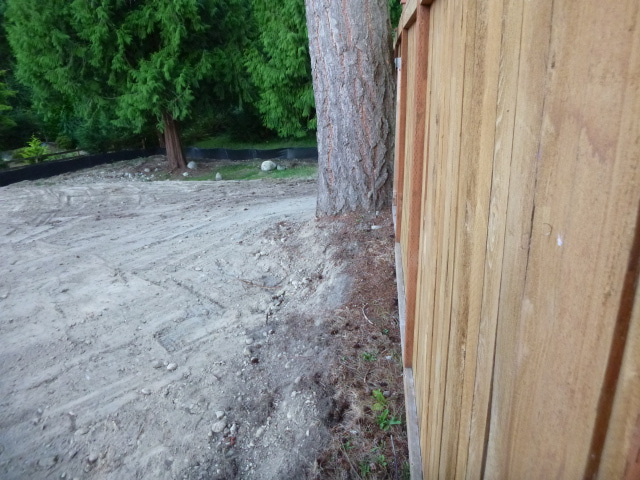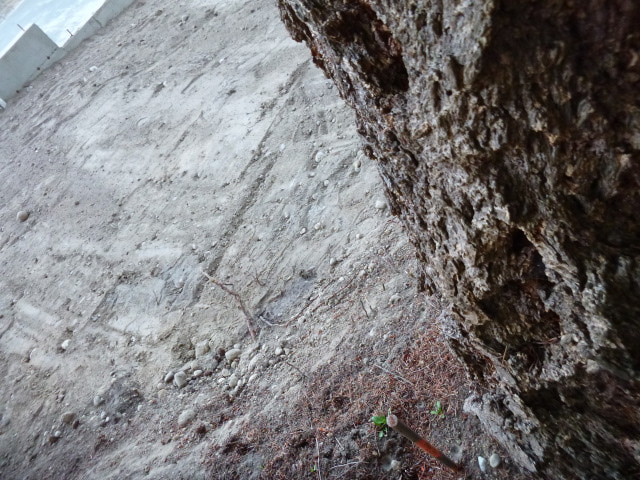Question
 Douglas Fir 1
Douglas Fir 1  Douglas Fir 2
Douglas Fir 2
There is a new house being built next to our 40+ year old house. Today they dug out the dirt approximately 12-18 inches down very close to an 80+ year old Douglas Fir on the property line. Hopefully the potential extent of the damage to the roots is apparent from the photos.
There are clearly severed roots, the largest being finger sized. We are certain none of the main structural roots were damaged. This same tree survived with no apparent ill effects a trench dug about 5 feet away from the intersection of the trunk and the ground 6 years ago. This digging is much closer. Regardless, we had an arborist examine the tree then (6 years ago) and he said if there were no ill effects in 5 years we were probably OK.
But now this has happened. Honestly, we like the tree and would prefer it stayed, but we don't want to pay for its removal if the damage done by the construction company has compromised it.
The tree is safe and protected on our side but there's not a whole lot of room between the tree and the asphalt driveway. We water the tree during the dry season.
I know it may be difficult to make an assessment based on the limited information. Should we consider removing the tree, at the construction company's expense, or hope for the best? Any help you can offer is appreciated.
Answerwell it is difficult to determine the amount of root damage you have to this tree. It looks like about half the circumference of the area under the tree was damaged.
Trees depend on the feeder roots in the upper 6 to 12 inches of soil for air, water and minerals. Most feeder roots are in an area under the tree crown in open-grown trees. If you extend perpendicular lines from the widest portions of the tree crown to the ground and connect these points, you抣l enclose an area that includes most of the root system.
The extensive shallow (feeder) roots usually extend 1/ 3 to 1/2 gain the drip line-to-trunk distance beyond the drip line of the tree. Grading, cutting, or trenching around oak trees is often detrimental due mainly to the shallow feeder roots being cut or damaged by machinery, or exposed by scraping away the topsoil. This may weaken the tree by reducing its ability to take up water and nutrients from the soil.
Because most of the roots are in the upper 6 to 12 inches of soil, lowering the grade and consequently removing those roots under a tree crown can be harmful
How much can you dig--I would say very little if any without damaging the root system. Conifers like Doug Fir have a tap root so they can survive more root damage than say oaks or hardwood trees. The tap root will also give it more stability. The general rule is not more than 1/3 of the root area can be damaged without causing dieback to the foliage. This damage may not show up for a year or so OR until there is a drought. I think with the information I have you will have dieback of this tree--the root damage on one side and limited growing area on the other.
Looks like the tree is not on your property but very close to the line??!! I would discuss the tree damage with the neighbor and if you would rather keep the tree come to and understanding that is it dies they would be responsible for the cost of removal. IF it is your tree then you will need to make the discussion to keep or remove. IF the construction company can remove it I would with the information I have lean toward removing it now. If you keep is I would fertilize it with 10-10-10 fertilizer at the rate of 1 lb. per inch of trunk diameter scattered around the tree and watered in good. Apply the fertilizer just before a rain storm and you will not need to water. This fertilizer will increase the root growth and in turn increase the overall health of the tree. Fertilize this winter and gain in the spring.







